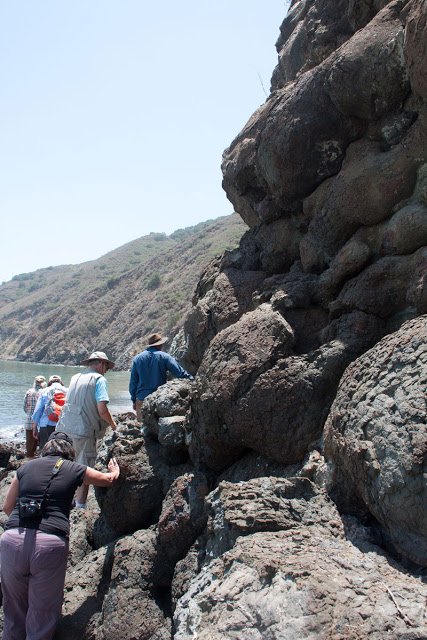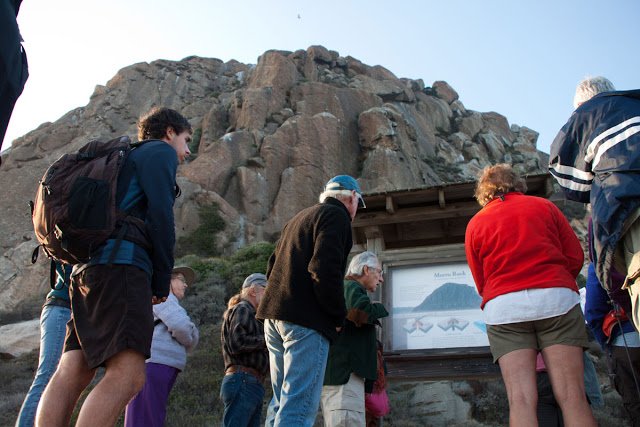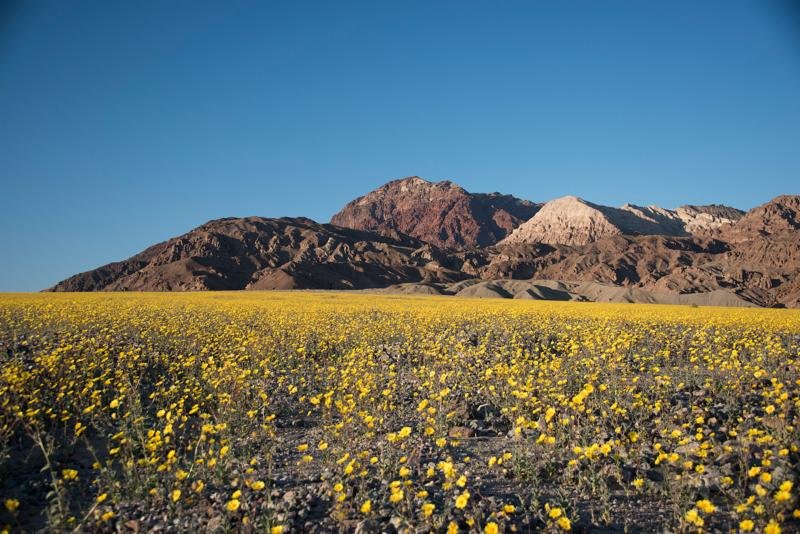About Our Environmental Education Tours
CIR will again offer our popular educational tours to fabulous mainland locations. Led by Geologist Tanya Atwater, Botanist Steve Junak and birding experts, these trips have become very popular and often sell out early! Don’t miss your chance to join these educational to scenic locations like the White Mountains, Death Valley, the Channel Islands and the Central Coast.
Although our current tours have all concluded for the year you can sign-up for updates by joining our volunteer email list. From there, you will receive news and updates regarding our educational programs.
Types Of Environmental Education Tours
White Mountains Educational Tour
Participants on a CIR White Mountains tour enjoy music around the campfire.
Tanya Atwater discusses geology with participants on a CIR White Mountains tour.
This will be our fifth tour of the fascinating White Mountains of Eastern California. Last summer 25 participants joined us from all over California as we spent four days visiting ancient trees, spectacular vistas and exceptional geology. We stay at the Crooked Creek research station, which is set in a bristlecone and limber pine forest at 10,200 feet in altitude.
Station staff cook all of our meals, and we are treated to evening presentations by Tanya Atwater and Santiago Escruceria, our local birding expert. The ancient bristlecone pines are one of the most exotic and interesting features of the White Mountains.
These are the oldest trees in the world; one of them has been dated at nearly 5,000 years old! We hike in two of these groves in guided explorations of the trees, wildflowers, birds and other animals that inhabit these high-altitude ecosystems. July is spring time in the high mountains! Each day we take auto tours and short to medium length hikes to the pines and many great views and wildflower spots.
We also visit Barcroft Station, a unique facility for high-altitude research, and we offer an optional hike up nearby Mount Barcroft, at just over 13,000 feet. For more information about the CIR White Mountains trip, visit the trip web site: cirweb.org/whites
Death Valley National Park Educational Tour
Participants in the CIR Death Valley tour pose for a photo at Aguereberry Point, a spectacular view point above Death Valley.
Big-horned sheep seen on a CIR Death Valley tour.
This will be our third tour to the park. The five day adventure begins with a visit to the Maturango Museum in Ridgecrest. We then head for camp at the Trona Pinnacles, which has some of the most unusual geological features in the California Deserts. The next day we enjoy many botany and geology stops and a spectacular view of Death Valley from Aguereberry Point. We stay three nights at Furnace Creek in the floor of the valley. We stay in the campground, or participants can stay in their own RVs or in the nearby hotel (at their own cost)
Over the next two days we enjoy a spectacular drive through Titus Canyon, a hike up Mosaic Canyon, and visits to Ubehebe Crater, Dante’s View, Zabriskie Point, Badwater, the Salt Creek pupfish ponds, and various botanical and birding sites.
Even though 2013 was a dry year, we still found some stands of lovely desert wildflowers, so we will be looking for those again! We even got a close-up look at big-horned sheep near Aguereberry Point!
For more information on the Death Valley trip, visit the trip web site:
Central Coast Natural History Education Tour
This has special emphasis on the geological history of California with Dr. Tanya Atwater. This is a travelling, four day camping trip, with the option to stay in hotels. We camp at Morro Bay State Park, Pinnacles National Park, and Pfeiffer-Big Sur State Park.
We are glad to provide a few photos from Channel Islands Restoration’s recent Central Coast Natural History Tour. Geologist Tanya Atwater and botanist Steve Junak joined us on a four-day tour, following the San Andreas Fault north to Hollister, CA then south along the Big Sur Coast. CIR leads natural history educational tours to exceptional locations in southern and central California with leading naturalists. For more information on our three reoccurring trips (held in the spring to early summer) visit our tour web site: http://www.cirweb.org/nht
The tour begins at Port San Luis (Avila Beach). We walked, climbed on, and explored the pillow basalts and lava flows of a world-class example of ancient oceanic crust. Tanya Atwater has been on submersible dives, miles deep to study how the present-day ocean floor is being formed at sea floor spreading centers. She described her adventures to us and shared her insights into the processes that formed the various exotic features encountered at this site. This may be the world's best location to visit the deep sea floor in the sunshine.
Next stop: Montana de Oro State park. This was a great beach stop. It is surrounded by the cut faces of huge uplifted marine terraces and it contains a sweet, small erosional remnant of a terrace that we checked out close up. The terraces are very strong evidence of the ongoing rising of the land that is so common along the California coast. Views of the higher hills showed a whole staircase of uplifted terraces, formed as ice age sea level fluctuations interacted with the steadily rising land. The road to Montana de Oro featured a fantastic view of Morro Bay and Morro Rock.
We also enjoyed golden yarrow in bloom!
After several other stops, we ended up in Parkfield.
As we approached this sweet ranch town, we examined an interestingly deformed bridge, then cross over the San Andreas Fault from the Pacific plate to the North American plate. We learned about the Parkfield earthquake prediction experiment and about the deep drilling, fault-crossing experiment.
We then stayed the night at Pinnacles National Park. This park is centered around a huge heap of broken rocks that have been offset from a volcano whose lava flows lie in the Mojave desert. They have been shifted 325 km northwestward along the San Andreas Fault sometime since 23 million years ago. We hiked up stunning wooded trails with Steve and Tanya. We spent the night at the East Pinnacles National Park campground (some in hotels in Hollister).
We spent an hour walking up and down the streets in the old neighborhoods of Hollister, tracing the Calaveras Fault as it crosses and deforms sidewalks, curbs, buildings, telephone poles, etc.
We then explored Point Lobos State Reserve. We walked into the park and enjoy this beautiful natural treasure. We explored rocks that were deposited in an offshore submarine canyon and seek out trace fossils left behind by the Eocene creatures that lived there. We experienced a rare, native Monterey Cyprus grove and other botanical wonders. We looked for otters, sea lions and birds and enjoyed the many breathtaking views.
Steve Junak led us on a great botany walk!
We drove south along Highway one, checked into Pfeiffer Big Sur State Park (or hotels) then enjoyed dinner at the Big Sur Lodge. We drove south along Highway one, checked into Pfeiffer Big Sur State Park (or hotels) then enjoyed dinner at the Big Sur Lodge.
The next morning we enjoyed a hike at Julia Pfeiffer Burns State Park. This cliff-top park was the home of early Big Sur settlers. We enjoyed a waterfall leaping into its pocket beach and enjoyed incredible ocean views.
Further down Highway One, we spotted a California Condor! We then drove the Nacimiento-Fergusson Road to the crest of the range, taking in spectacular views of the coast and the Los Padres National Forest. Steve Junak led us on a plant walk in the Coast Redwoods. We were treated to a great view of a pygmy owl!
We were then treated to a specially arranged tour of the Point Piedras Blancas Lighthouse. This historic location is a great place to admire a very successful native plant restoration project. We enjoyed its great coastal views and bird populations and explored the old buildings and equipment of this long-functioning lighthouse.
White-crowned sparrow in native Lupine at the Point Piedras Blancas Lighthouse
View from the top of the Point Piedras Blancas Lighthouse
View from the top of the Point Piedras Blancas Lighthouse
Central Coast Train Tour (Retired)
On a gorgeous Day in March, over 50 CIR volunteers and donors were treated to a unique trip in a classic dome lounge-dinning train car up the coast to San Luis Obispo and back. The restored Silver Splendor dating from 1956 has a dining area below and the dome seating above. Steve Junak, consummate botanist and historian told tales of the ranches and other interesting spots and old towns, while highlighting the ecology and wildflowers along the way.
Tanya Atwater, world-renowned geologist, shared her extensive knowledge of the geology of the Santa Ynez Mountains and the Pacific coast along the way. Passengers arrived at the Santa Barbara train station in the morning, and half were seated in the dome car with the guides while the others lounged in the lower diner portion of the car.
On the return trip, the group switched locations on the train. Passengers were also served tasty drinks including coffee, mimosas, wine and beer and soft drinks, plus a delicious buffet lunch. Tickets for the trip sold incredibly quickly and was enjoyed by all. Because of this we plan to host another tour in the Silver Splendor this fall.
Stories From Our Environmental Education Tours
This year's spring and summer natural history trips were truly exceptional. Our Death Valley trip took place right at the height of the super-bloom and the once bare and desolate floor of the valley was carpeted with desert gold and pocketed with dozens of other native desert wildflowers.
This past El Niño brought torrential amounts of water to many parts of California that desperately needed it (while also inexplicably missing others) and over the course of the winter Death Valley received a full 2.7 inches of rain. This amount may seem insignificant, but the Valley normally receives no more than 2 inches of rain in an entire year. This small, yet concentrated amount of rain, was enough to germinate millions of dormant desert wildflower seeds that all shot up to form a massive super-bloom - the likes of which the valley has not seen since 2005.
While the super bloom was spectacular and novel, it was unable to dwarf Death Valley's usual splendor of barren rocks, braided badlands, and the bed of a long-dead lake - the story of which Dr. Tanya Atwater unfolded over the course of the trip. Meanwhile, Steve Junak told stories of present day life in Death Valley and how the native plants and wildlife are able to carve out a niche in one of the harshest and most desolate regions of the world.
A few months later during the hot summer months, we ventured high into the White Mountains to walk in the cool mountain air among the oldest trees in the world. At first glance, the high peaks of the White Mountains reveal little more than ancient trees among the barren rock, but the land came alive through interpretation from Tanya Atwater, Steve Junak, and Santiago Escruceria.
Concentrated beauty could be found all around in the low-lying flowers that lay hidden within the rocky crevices which gave shelter to the biting wind. This tiny and hidden beauty lay in contrast to their home atop the massive mountains that were left from the collision of two massive continental plates.
Trips to these unique and spectacular locations happen every year, so be on the lookout for our natural history trips to Death Valley and the White Mountains. Both trips sold out every year over the past six years, so act quickly to make sure you don't miss out! In addition to these, this year we will be hosting two more natural history trips this spring: one along the Central Coast and another on a luxurious train ride between Santa Barbara and SLO.
The Central Coast trip will focus on the area surrounding the San Andreas Fault. It will form a loop that begins at Morro Bay, and from there we'll travel north to the volcanic formations at Pinnacles National Park, then west to Hollister, south through the coast of Big Sur, and we will end with a tour of the Piedras Blancas lighthouse.
And finally, we'd like to welcome all aboard on an amazing excursion led by the extraordinary geologist Tanya Atwater, and Steve Junak, botanist, storyteller, and CIR Board Member. This exciting trip will offer rare glimpses of some of the last original native coastal landscapes in Southern California. Beginning at the Santa Barbara train depot, you will ride in style aboard a beautifully restored Vista Dome Lounge-Dining Car built in 1956.
You will be treated to a narrated scenic journey along a spectacular part of the coast, and through several ranchos that cannot be seen from Highway 101. We will travel through Gaviota, the Hollister Ranch, the Cojo Ranch (including Point Conception), Vandenberg Air Force Base (including the Sudden Ranch), and the Guadalupe / Oceano Dunes region. Learn about the area's rich human and natural history before stopping in San Luis Obispo. Enjoy a catered buffet lunch on board, including beer, wine and soft drinks. Passengers are free to change levels and sides in the car for a new and different view on the way back. This is a fantastic opportunity to see parts of the coast by rail that are otherwise inaccessible.













